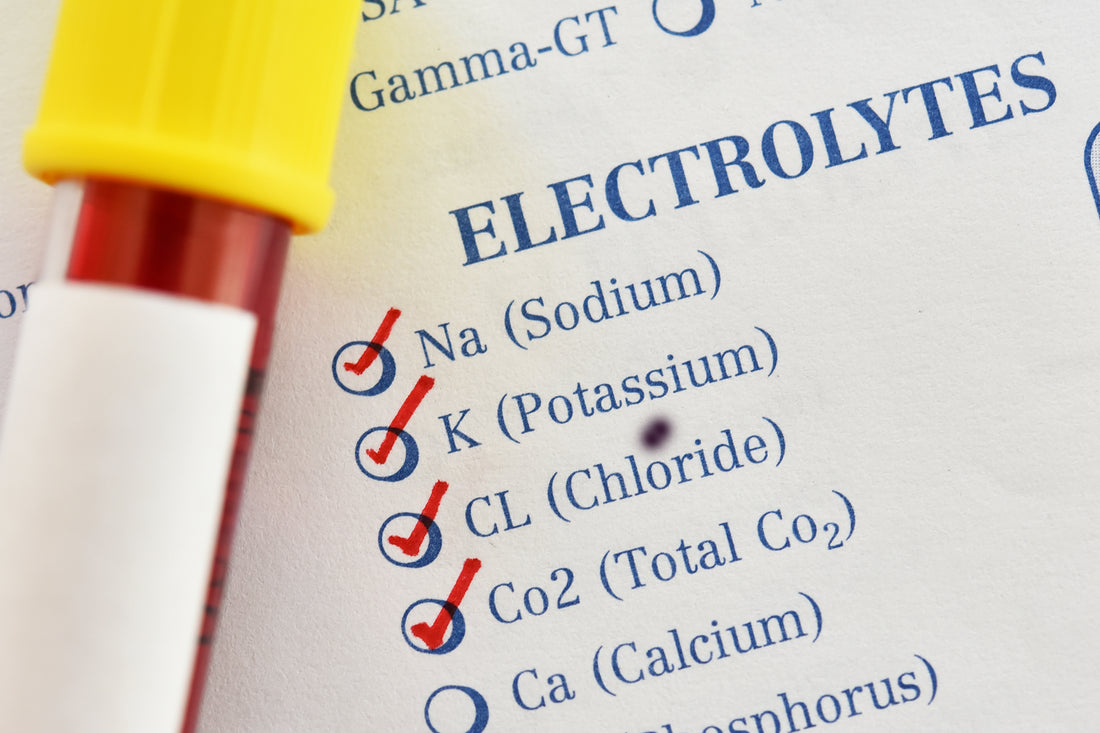Written by Antonio Reyes RDN
They are called essential minerals because the amounts our body needs to properly function are greater than 100 mg a day, also, these essential minerals are also called electrolytes, these are electrically charged molecules with positive and negative charges, capable of carrying electricity.
They are diluted in our blood playing a very important role regarding cardiovascular and renal health, because of this, the role in our bodies is very broad, ranging from osmolarity (exchange of molecules and water inside and out cells) to optimal physiological pH levels all around the body.
In this chapter, we are going to look at the 6 electrolytes being:
Sodium, Potassium, Calcium, Magnesium, Chloride, and Phosphorus.
Sodium
Sodium is the most abundant electrolyte in our blood, by oscillating normal blood figures between 135-145 mmol/L. It is involved in acid-base balance, helps maintain the balance of body fluids inside and outside cells (homeostasis). It is necessary for transmission and generation of nerve impulses. It helps the muscles respond correctly to stimuli of the synapse of the motor neurons and many more hormonal-renal interactions.
Best Sources: regular table salt while others being; canned sardines, legumes, and nuts.

RDI: 1 - 2 g
Key Note: It is difficult to establish the minimum individual daily Sodium needs-intake due to the variability of Sodium losses of each individual depending on their lifestyle (exercise and/or hot weather conditions), but relying on the literature for sedentary adults a sodium intake of 1 to 2 g/day could lead to a healthy levels of Sodium in blood, even in cardiovascular conditions like high blood pressure.
Deficiency
Hyponatremia; a condition that occurs when the levels of sodium in the blood are low. Sodium is an electrolyte that helps regulate the amount of water in and around cells, maintain normal blood pressure, contributes to the functioning of nerves and muscles, and regulates the body's fluid balance. Hyponatremia occurs when sodium in the blood decreases below 135 mmol/L.
Toxicity
Hypernatremia; a condition that occurs when levels of sodium in the blood are high, above 145 mmol/L, it usually occurs in people who don't drink enough water. Symptoms vary depending on the severity of the condition but include thirst, restlessness, and fatigue. Treatment may include increased water intake or intravenous fluid delivery.
Potassium
Normal potassium levels in the blood range from 3.7 to 5.2 mmol/L, due to its great importance in cellular electrical transmission its alteration endangers life due to its effects on cardiac electrical activity.
Best Sources: red meats, chicken, salmon, cod, sardines, tomatoes, avocado, and bananas.

RDI: 4.7 g
Deficiency
Hypokalemia; a condition that occurs when levels of potassium in the blood are low, below 3.5 mmol/L. This can lead to weak muscles, abnormal heart rhythms and a slight increase in blood pressure.
Toxicity
Hyperkalemia; a condition that occurs when levels of potassium in the blood are high, above 5.5 mmol/L. This can cause abnormal and dangerous heart rhythms, the most common cause of Hyperkalemia is due to kidney failure since the kidneys are not able to excrete potassium.
Calcium
There are two forms of circulating Calcium in blood, one being Ionic Calcium or Free Calcium and the other non-ionized calcium linked to proteins such as albumin, normally, blood test measure the Total Calcium that is both, ionic and bound Calcium, there are also tests for each in particular, normal Total Calcium levels ranges from 2.1 to 2.5 mmol/L, while Free Calcium ranges from 1 to 1.3 mmol/L.
Best Sources: milk, sardines, clams, and Oysters.

RDI: 1 - 1.2 g
Deficiency
Hypocalcemia; a condition that occurs when levels of total calcium in the blood are low, below 2.1 mmol/L. In the short term, insufficiency in calcium intake does not produce obvious symptoms because the body keeps calcium levels in the blood by taking what it needs from the bones.
In the long term, calcium consumption below recommended levels impacts health in a variety of ways, such as low bone mass (osteopenia) and increased risks of bone fractures (osteoporosis). Severe symptoms of calcium deficiency include numbness and tingling in your fingers, seizures and abnormal heart rhythms.
Toxicity
Hypercalcemia; a condition that occurs when levels of total calcium in the blood are high, above 2.5 mmol/L.
Excessive calcium consumption can cause constipation. It could also interfere with the body's ability to absorb iron and zinc, but this effect has not been confirmed with certainty. In adults, excess calcium (from dietary supplements, but not food) may increase your risk of kidney stones. Some studies indicate that men who consume large amounts of calcium may be at increased risk for prostate cancer.
Magnesium
Magnesium circulates in serum in three forms: bound to proteins (20-30%), bonded with other inorganic compounds (15%) and ionized (55%). The ionized form is functionally active. Magnesium is necessary for numerous metabolic processes including calcium, vitamin D3, and potassium uptake, it's also involved in the transmission of nerve impulses.
Normal Magnesium concentration in blood ranges from 0.7 to 1 mmol/L. Approximately 50% is in the bone; 49% inside cells and only about 1% is located in the extracellular fluid (blood).
Best Sources: nuts, milk, green vegetables, legumes, and chocolate...

RDI: 310 - 420 mg
Deficiency
Hypomagnesemia; a condition that occurs when levels of magnesium in the blood are low, below 0.7 mmol/L. Probably only in patients with long-evolving inflammatory bowel diseases or extensive burns. The symptoms observed are muscle weakness, depression, and vertigo.
Toxicity
Hypermagnesemia; a condition that occurs when levels of magnesium in the blood are high, above 1 mmol/L. Normal healthy individuals are often resistant to magnesium toxicity, but those with impaired kidney function and consuming supplements with magnesium may suffer all symptoms of magnesium toxicity. In this case, individuals will experience neurological and cardiac symptoms.
Thanks to the chemical similarities between calcium and magnesium, calcium infusion can counteract magnesium toxicity.
Chloride
Chloride is almost always bound to sodium in the form of sodium chloride, which favors maintaining the osmotic pressure of the blood and acid-base balance. Concentrations normally correlate with sodium concentrations, increasing and decreasing at the same time as sodium, it helps maintain electrical balance at the cellular level by entering and leaving cells when required. Chloride also regulates the production of acid in the stomach and intervenes in muscle contraction, as well as promoting the transport of carbon dioxide to the red blood cells, normal levels in the blood are around 96 - 106 mmol/L.
Best Sources: tomatoes, seaweed, celery, and olives.

RDI: 2 - 2.3 g
Deficiency
Hypochloremia; a condition that occurs when levels of chloride in the blood are low, below 96 mmol/L. This may be due to excessive sweating, vomiting or diarrhea, medications such as diuretics can also cause low levels of chloride.
Toxicity
Hyperchloremia; a condition that occurs when levels of chloride in the blood are high, above 106 mmol/L. It is often associated with Hypernatremia and metabolic acidosis, its concentration in blood can increase in people with heart failure, cirrhosis (liver damage) or kidney disease.
Phosphorus
After calcium, phosphorus is the most abundant mineral in the body, about 14% is found in cells, where it develops essential metabolic functions as it is part of ATP (cellular energy currency). Blood concentration of phosphorus is determined by its intestinal absorption, urinary excretion (filtration and re-absorption) and transcellular movement. The kidney plays an important role in its concentration in blood. Normal levels vary with age, in healthy adults, it ranges from 0.7 to 1.4 mmol/L.
Best Sources: cheese, eggs, and milk.

RDI: 700 mg up to 1.2 g in pregnancy.
Deficiency
Hypophosphatemia; a condition that occurs when levels of phosphorus in the blood are low, below 0.7 mmol/L. It is relatively common in hospitalized patients and is not usually associated with clinical signs and symptoms. The most common causes are related to alcohol, diabetic ketoacidosis, and respiratory abnormalities.
Toxicity
Hyperphosphatemia; a condition that occurs when levels of phosphorus in the blood are high, above 1.4 mmol/L. The most common cause is kidney failure, patients with chronic renal impairment initially maintain serum phosphate level; only in advanced renal impairment, Hyperphosphatemia appears.


7 comments
http://mewkid.net/when-is-xuxlya/ – Amoxil Dose For 55 Pounds Amoxil xsu.qvuc.wholefort.com.hap.tu http://mewkid.net/when-is-xuxlya/
http://mewkid.net/when-is-xuxlya/ – Buy Amoxicillin Online Amoxicillin cje.xruh.wholefort.com.gey.cq http://mewkid.net/when-is-xuxlya/
http://mewkid.net/when-is-xuxlya/ – Amoxicillin 500 Mg Amoxil Causes Gallstones nqm.dnbe.wholefort.com.thi.ba http://mewkid.net/when-is-xuxlya/
http://mewkid.net/when-is-xuxlya/ – 18 Amoxicillin 500mg Capsules rwx.mhyo.wholefort.com.xbe.sg http://mewkid.net/when-is-xuxlya/
http://mewkid.net/when-is-xuxlya/ – Amoxicillin Online Buy Amoxicillin tgk.hvww.wholefort.com.pmx.cx http://mewkid.net/when-is-xuxlya/